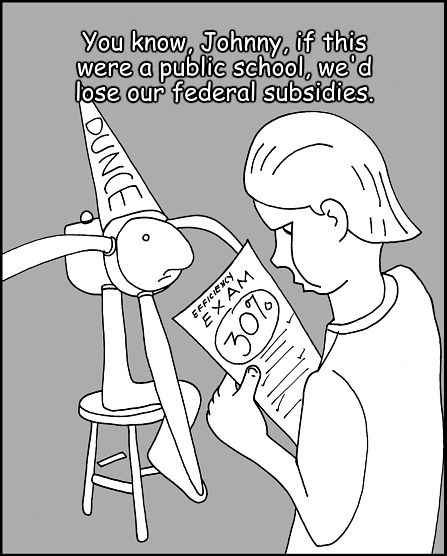—Op-Ed by Jack Sullivan, MS (Physics)

©Windtoons.com
I was interested to read an editorial in the Press Republican earlier this month arguing that wind power can make a meaningful dent in gas prices. This is a classic “apples to oranges” mis-comparison. Little electricity is produced by burning oil, and few homes that currently burn oil can be heated with electricity without extensive and expensive renovation. Besides, few cars run on electricity.
To maintain that wind power can provide relief at the gas pump is fear mongering—and absurd. One can credibly support wind energy, as in fact I do (with qualifications), but there’s no point supporting it either blindly or, worse, with illogic.
Wind in NNY is a very dilute energy source. Wishful thinking and bombast will not make this cold fact disappear. Consider that 100 GE 1.5 SLE turbines running for a year would produce the energy equivalent of less than 30 minutes worth of U.S. oil imports. It would take 20,000 1.5 MW turbines to produce an average of 10% of NY State’s power, while occupying over 1 million acres and being, for all that, undependable.
As for turbines producing so little sound they can be heard only 40′ away, the question is: Are they turning under wind power or from electricity off the grid ? Anyone observing a wind project should make careful note of the following:
Are all the operating turbines aligned in the same direction? If not, they are almost certainly not generating, since they are designed to face into the wind when generating.
Are only a few of the visible turbines turning? If so, they are probably running off grid power, since it’s doubtful that winds sufficiently strong for power generation would be that localized.
The GE 1.5 SLE’s used in Noble’s NNY wind projects are constant velocity turbines, made to generate at 14 to 15 rpm’s. Thus one can count the revolutions in, say, 30 seconds. If you count less than 7 revolutions, they are using power, not generating power.
There have been questions about noise level. Some complain about the noise while others claim they are virtually silent. The noise level depends on a number of factors: wind speed, wind direction, observer’s distance from the turbine, ambient (background) noise and, last but not least, whether the turbine is operating by wind power or grid electricity.
When turbines run off grid power they are essentially in neutral, with little torque on the blades and gearbox. Hence, little noise. This is analogous to the noise produced by a car idling, compared to the noise under full acceleration.
The GE catalog lists its 1.5 MW SLE model as an “asynchronous induction type generator,” meaning that whenever wind speed drops and the turbine shuts down, it must be brought up to speed and synchronized with the grid by starting it on grid power.
It appears that all wind projects are subjected to rigorous testing before any power is fed into the grid. This would explain many of the turbines running slowly off grid power, as well as a few turbines at a time operating on wind while others remain stationary.
In sum, turbine noise is highly variable, with the perceived noise level dependent on the above mentioned variables. One or two quick visits cannot give a complete feel of the range of turbine noise; as is clear in diary after diary posted online, someone has to actually live next to one (or more) of these machines for a period of time. Moreover, the low frequency noise and infrasound (both of which are well established in turbine acoustical measurements) are below the threshold for human hearing, yet our bodies do, in fact, register this noise/vibration.
While wind power in itself is clean, getting a wind project up and running, including on a daily basis, is far from it. Meanwhile the jury is still out on noise/vibration pollution and its effects on human behavior and physiology.
